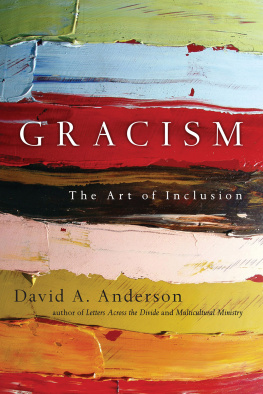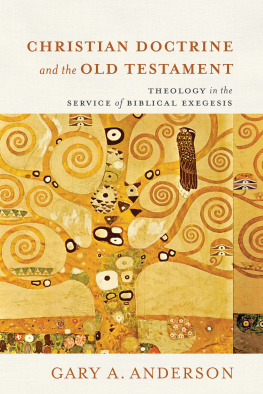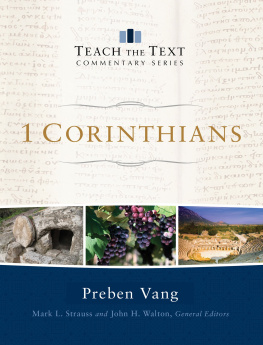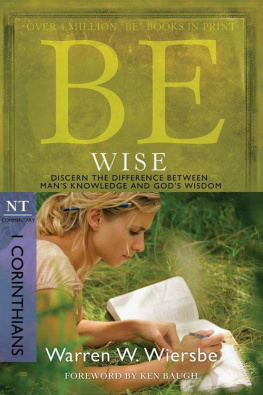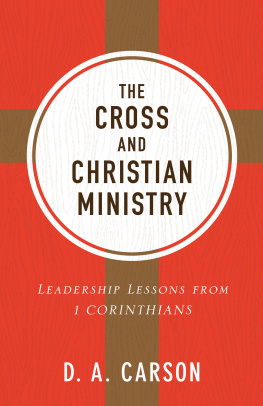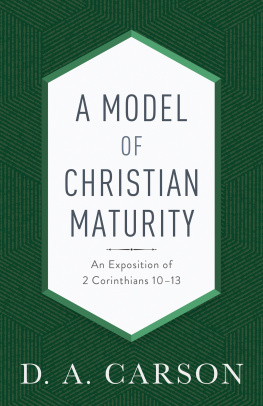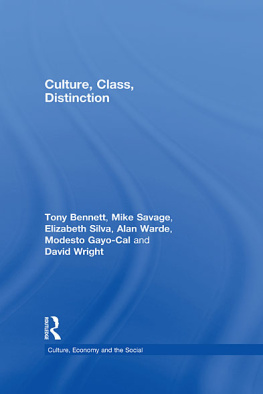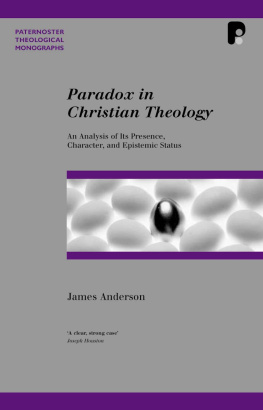David A. Anderson
2007 by David A. Anderson
All rights reserved. No part of this book may be reproduced in any form without written permission from InterVarsity Press.
Introduction
E xcited about my opportunity to serve as an intern at Willow Creek Community Church in South Barrington, Illinois, I was looking forward to my rst day on the job. After three years of Bible education in downtown Chicago at Moody Bible Institute, and two years of urban pastoral ministry in Cabrini Green, a poor black neighborhood replete with high-rise apartments fencing in humans like rats in a cage, I was now about to enter a completely different experience.
As a tall African American male, my new reality as a Willow employee placed me in a suburban context among a sea of white people. This context included beautifully designed mansions and shiny luxury vehicles that occupied multiple garages. The landscaped lawns were works of art religiously primped and usually cared for by Hispanic men who edged and mowed the well-manicured acreage. It was a far cry from the urinestained elevators and grafti-ridden projects of Cabrini.
I wasnt raised in either extreme. I didnt come from wealth or poverty. Both of my parents worked full-time jobs outside the home but made it home each night by dinner time, when we all ate together. Our single-family home was a small brick Cape Cod with three bedrooms, one bathroom, a basement and a yard surrounded by a chain-link fence. My father worked for the federal government, while my mother worked for the state of Maryland. We four children attended public schools. During my elementary school years, I stayed with a neighborhood daycare provider after school until Mom came home from work.
Heading to Chicago was a big deal for me because I had seldom traveled beyond the Washington metropolitan area. My home metropolis was demographically diverse and there everyone seemed to work hard to hold down their jobs, pay their mortgages and protect their families from the social ills of drugs and violence. Once I landed in Chicago, though, the extremes of racial existence were stark. It seemed as if the majority of whites were rich and educated, while the blacks were poor and uneducated. The Hispanics were in their own enclaves and the Asians were seemingly invisible except in Chinatown or Korea town. For me as a minister in my twenties, my views about diversity, class distinctions, social conditioning and racial reconciliation were challenging my vision for multicultural ministry amid the extremes of society.
While I had grown up conscious of race and the differences that plagued our country both personally and systemically, I had never felt as powerless as I did on my rst day as an intern at Willow. The day was marked by a racially penetrating event that is etched in my memory. As I commuted to the church that rst morning in a rusted-out blue Honda Civic, I noticed blue lights ashing in my rear-view mirror. A police ofcer was signaling me to pull over. With my hands in clear view, I gave the ofcer my license and registration. He went back to his vehicle. I assumed he was checking my information on the computer and doing whatever else police ofcers do in their cars while the stopped driver sits in embarrassment along the side of the road as motorists pass and gawk.
When the ofcer returned to my drivers side window, he handed my license to me. I was dismissed.
Before you leave, sir, can you tell me why I was pulled over? I asked.
The ofcer responded, You t the description of someone we are looking for.
I took him at his word.
Had that been my only experience of being pulled over that day, I would have believed that the inconvenience of mistaken identity could have happened to anyone. But a few hours later I drove off the church campus to get lunch. Again I had the sinking feeling in my stomach that comes with the realization that one is being stopped by a police ofcer.
Whats wrong now? I said aloud to myself. Bad luck indeed, I thought.
Like it was dj vu, I went through the same delay that made me late on my rst day of work earlier that morning. I received from the second ofcer the same explanation given to me by the rst cop who had stopped me. You t the description of someone we are looking for, he said. At this point I thought it would be great if the ofcers could make a note in their system to let everyone know that David Anderson was not the guy they were looking for! I was upset.
What made the day so memorable was not the orientation to one of the coolest megachurches I had been exposed to at the time or the grace with which the staff greeted me when I was introduced. What was most memorable was that I was tardy on my rst day as an intern due to a delay from a police ofcer. The day is memorable because I was stopped again on my way to lunch. But if that were the end of the story, we could record this scenario as a minor inconvenience that all people in the suburbs of Chicago might have to endure on occasion. Unfortunately, on my way back from lunch, I was stopped by a third ofcer. Before the day was over, I had been stopped by four police ofcers. Three were male, one was female and all were white. I never received a ticket or harsh treatment, thankfully.
Can you imagine the frustration, the anger and even the selfquestioning that were unearthed inside me? Years before this incident, I had become convinced that God had called me to reconciliation and multicultural ministry. I was a minister of the gospel and more importantly a Christ follower. I cannot imagine the bitter attitudes and negative behaviors that would have come out of me had I not been tempered by the Holy Spirit living inside me at that young age of twenty-three. The Spirits presence did not relieve me of the deated feelings I experienced that evening after my rst day of work. I reected on the days events and anger gave way to the comfort of the Holy Spirit. God reiterated in me that this was why my life must be committed to building bridges of reconciliation.
What I experienced that day was racism. What I envision is a world that can move from racism to gracism. Gracism, unlike racism, doesnt focus on race for negative purposes such as discrimination. Gracism focuses on race for the purpose of positive ministry and service. When the grace of God can be communicated through the beauty of race, then you have gracism. My prayer is that this book will move Gods people closer to achieving such a worthy vision.

